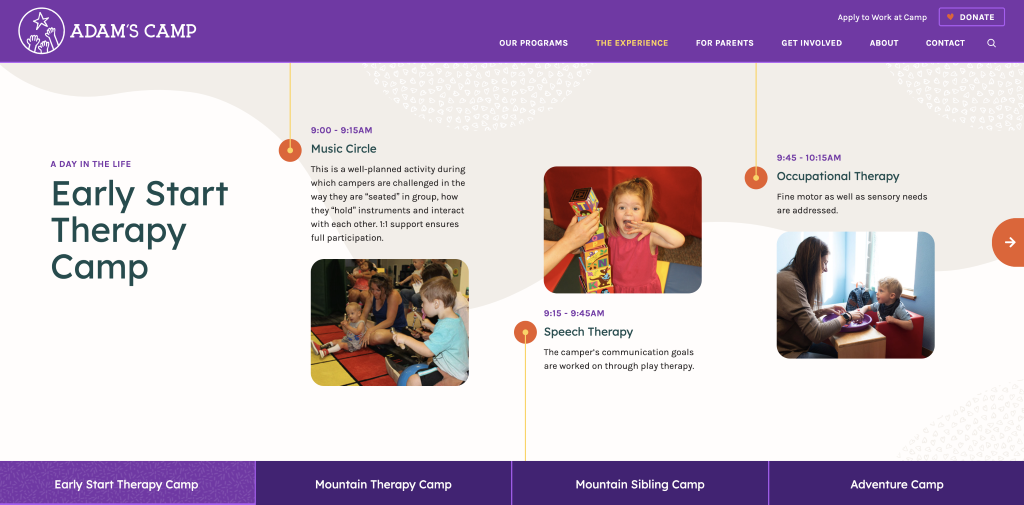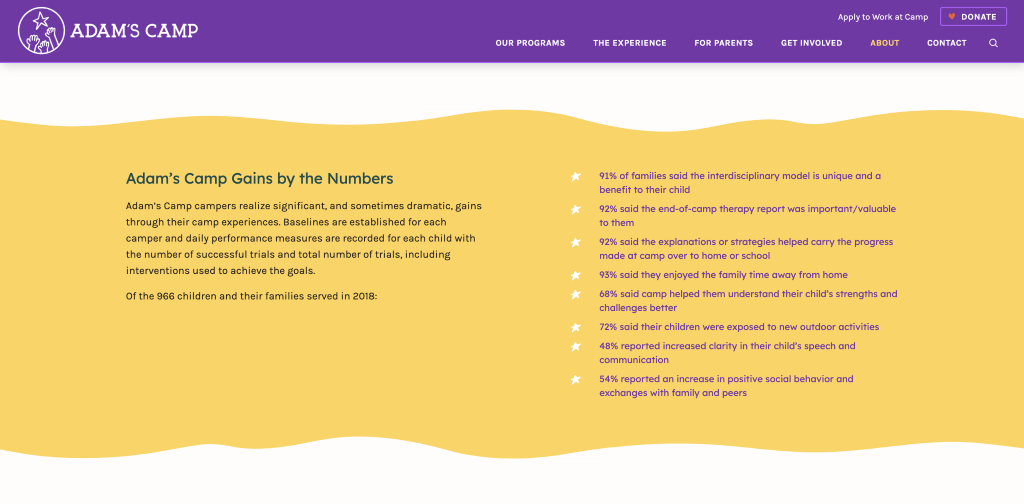In a world of providing critical needs and fighting for donation dollars, all on a shoestring budget, non-profits need to project clarity and focus more than the average website. Getting there isn’t always easy. But having an outside agency look at your offering and website with fresh eyes is a great start.
While Gravity has deep expertise in B2B and B2C clients, you may not know we also have a long history of working with non-profits. That’s why we were thrilled when we were given the opportunity to work with Adam’s Camp, a non-profit therapy and adventure camp designed to help special needs children, youth and adults, and delivered by trained therapists.
Having worked with several non-profits, we wanted to share our perspective on what goes into making a great non-profit website.
Identify your primary and secondary audiences
Non-profits are always being pulled in different directions. But prioritizing your audiences is key to making sure your website doesn’t end up being more confusing than helpful.
List all your audiences.
- While donors are usually your primary audience, donors can often be broken down into different types, each of which may have different needs on the website. For example: potential new donors versus recurrent donors or even individuals versus corporate donors or sponsors
- Most non-profits are also using their website to provide services. These recipients may represent different audiences with different needs.
- Volunteers and potential employees are other audiences with different goals and needs.
- Press/media contacts need access to your mission, story and leadership
- The list can go on, make sure you list them all.
List the key pieces of information each audience will be coming to the website for.
- This is how you begin to identify who your personas are. It’s also helpful to begin understanding what content you may be missing and need to create moving forward.You may find that multiple audiences have the same or similar needs and goals.
Identify the primary audience of your website.
- Review your mission statement.Who are you serving? That’s most likely your primary audience.
Once you've identified your primary audience, you can start prioritizing the information architecture and overall experience to cater to their needs. Secondary audiences typically have a similar set of needs, and sections of content can be created to accommodate them without sacrificing the clarity and calls to action of the primary audience.
Getting your primary audience the content they need is priority number one
Yes, donations are critical. But donors are generally motivated audiences and if you maintain a clear donation button on your site, that should usually get them where they need to go. Getting your primary target audience the content they need should be priority number one.
Clearly articulate your mission, vision and offering
Clearly outlining your mission is content that should be either in your banner area or just below the banner, but it should be clearly listed on the homepage and on your About section. It should be 100% obvious what your mission is and the services you provide.
Identify what the critical content is for your primary audience
Interview customers if you can. In the case of Adam’s Camp, we were able to draw on the experience of their program staff and I was able to draw on my years of experience working the front-line phones for a non-profit adventure camp in my past.
Structure your site around the critical content
For Adam’s Camp, we were able to identify key content that was missing and get that clearly articulated in their global navigation. This included creating an engaging content section for campers to get excited about programming and a new section just for parents, outlining critical program details and how to pay for camp.
Inspiring action, including donations
Loud and proud calls to action are more important than ever when it comes to non-profit websites. This is not the time for a “soft sell” – it’s the time for the inflatable wacky dancer.
Prioritize your target audiences needs when identifying your primary call to action
Even if you want to get donations, your target audience’s call to action should be primary. If you don’t have a primary call to action outside of collecting donations, you’re in luck, your donate button should be loud and proud.
Example primary calls to action (besides donate):
- Apply for: camp, a grant, funding, etc.
- Find/connect with:funding partners, locations, a volunteer
- Become a member/join a group
Your primary call to action should be loud and proud in the upper right side of your navigation.
Pin your global navigation so it’s omnipresent in the upper right-hand corner of your desktop design. On mobile, have it outside AND inside your hamburger menu so it’s always present.
All pages should begin and end with your call to action
Ensure your banners and your final piece of content per page is inviting visitors to your calls to action specific to that page.
Create a section of content dedicated to action
For Adam’s Camp, we created a section dedicated to how you can get involved with the camp, assuming you were not attending camp. We outlined the ways you can donate, raise money, work and volunteer for Adam’s Camp. Grouping these together showed visitors the breadth of ways they can engage with the organization. Even if they were just looking to donate, they might know someone that was interested in working in volunteering. If these were in different sections, they might not get that visibility.
Have a little fun and tug on those heartstrings
Non-profit websites are a time to pull on those heartstrings. Whether you’re looking to provide comfort, inspire action or provide a critical service – now is the time to inspire through design.
Skip the Stock – Feature Real Faces
Feature high-quality photography of your actual programming. Know someone with a high-quality camera or can you get a photographer to work an event pro-bono? It will be worth it to bring your non-profit to life in a way that stock photography never can.

Be Bold
Want to inspire? Be bold! Now is the time to take a bold stance on who you are and take a heavy hand with your branding.

Use Facts
Facts and stats are an amazing way to showcase the efficacy and value of your non-profit. Work hard to get success stats, testimonials and proof points. They’re easy to scan and pack a powerful punch. Don’t skimp on the business side either. The best way to validate your need for donations is to prove their value through hard facts.

The Bottom Line: Clarity & Focus is Key
While we still follow our proven website process for non-profit organizations, the need for clarity and focus is more important than ever. Non-profit websites benefit from bold, vibrant design and photography that can bring their mission and vision to life.
While we loved creating a bold new brand for Adam’s Camp, we're most proud of how the website truly captures the spirit of their organization and helps parents and caregivers get their loved ones involved in one of these amazing programs. See more detail in our case study.
If you have a non-profit website that could use some love, we’d love to learn more about your amazing work and see how we can transform your online experience.
Share
Subscribe




